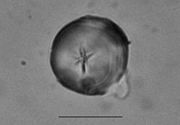
Florida arrowroot
Encyclopedia
Florida arrowroot was the commercial name of an edible starch
extracted from Zamia integrifolia
(coontie), a small cycad
native to North America
.
 Like other cycads, Zamia integrifolia is poison
Like other cycads, Zamia integrifolia is poison
ous, producing a toxin that affects the gastrointestinal tract
and nervous system
. The toxin can however be removed by careful leaching, and the roots and half-buried stems of this cycad were used by Native American people (notably the Tequesta
and Mayaimi
Indians, the Seminole Indians and the Maroons
) to produce this starch. The root is typically prepared by grinding (macerating) it using a wooden mortar and pestle
. The pulp is then saturated in water and drained. The drained fluid is allowed to dry and the resulting yellowish powder is used in the preparation of various foods. In commercial production, multiple macerations achieved a whiter color.
Commercial production of the starch (using roots gathered from wild plants) occurred in southern Florida from the 1830s until the 1920s. The starch was sold as Florida arrowroot
until the Food and Drug Administration
banned the practice in 1925. The last commercial "coontie starch" factory in Florida was destroyed by the 1926 Miami Hurricane
.
, a well known and high quality starch, was a marketing ploy. Because of this use, Zamia integrifolia is sometimes known as Florida arrowroot.
Starch
Starch or amylum is a carbohydrate consisting of a large number of glucose units joined together by glycosidic bonds. This polysaccharide is produced by all green plants as an energy store...
extracted from Zamia integrifolia
Zamia integrifolia
Zamia integrifolia is a small, tough, woody cycad native to the southeast United States , the Bahamas and the Caribbean south to Grand Cayman and Puerto Rico ....
(coontie), a small cycad
Cycad
Cycads are seed plants typically characterized by a stout and woody trunk with a crown of large, hard and stiff, evergreen leaves. They usually have pinnate leaves. The individual plants are either all male or all female . Cycads vary in size from having a trunk that is only a few centimeters...
native to North America
North America
North America is a continent wholly within the Northern Hemisphere and almost wholly within the Western Hemisphere. It is also considered a northern subcontinent of the Americas...
.
Use

Poison
In the context of biology, poisons are substances that can cause disturbances to organisms, usually by chemical reaction or other activity on the molecular scale, when a sufficient quantity is absorbed by an organism....
ous, producing a toxin that affects the gastrointestinal tract
Gastrointestinal tract
The human gastrointestinal tract refers to the stomach and intestine, and sometimes to all the structures from the mouth to the anus. ....
and nervous system
Nervous system
The nervous system is an organ system containing a network of specialized cells called neurons that coordinate the actions of an animal and transmit signals between different parts of its body. In most animals the nervous system consists of two parts, central and peripheral. The central nervous...
. The toxin can however be removed by careful leaching, and the roots and half-buried stems of this cycad were used by Native American people (notably the Tequesta
Tequesta
The Tequesta Native American tribe, at the time of first European contact, occupied an area along the southeastern Atlantic coast of Florida...
and Mayaimi
Mayaimi
The Mayaimi were a Native American people who lived around Lake Okeechobee in Florida from the beginning of the Common Era until the 17th or 18th century. The group took their name from the lake, which was then called Mayaimi, which meant "big water" in the language of the Mayaimi, Calusa, and...
Indians, the Seminole Indians and the Maroons
Maroon (people)
Maroons were runaway slaves in the West Indies, Central America, South America, and North America, who formed independent settlements together...
) to produce this starch. The root is typically prepared by grinding (macerating) it using a wooden mortar and pestle
Mortar and pestle
A mortar and pestle is a tool used to crush, grind, and mix solid substances . The pestle is a heavy bat-shaped object, the end of which is used for crushing and grinding. The mortar is a bowl, typically made of hard wood, ceramic or stone...
. The pulp is then saturated in water and drained. The drained fluid is allowed to dry and the resulting yellowish powder is used in the preparation of various foods. In commercial production, multiple macerations achieved a whiter color.
Commercial production of the starch (using roots gathered from wild plants) occurred in southern Florida from the 1830s until the 1920s. The starch was sold as Florida arrowroot
Arrowroot
Arrowroot, or obedience plant , Bermuda arrowroot, araru, ararao, is a large perennial herb found in rainforest habitats...
until the Food and Drug Administration
Food and Drug Administration
The Food and Drug Administration is an agency of the United States Department of Health and Human Services, one of the United States federal executive departments...
banned the practice in 1925. The last commercial "coontie starch" factory in Florida was destroyed by the 1926 Miami Hurricane
1926 Miami Hurricane
The 1926 Miami hurricane was a Category 4 hurricane that devastated Miami in September 1926. The storm also caused significant damage in the Florida Panhandle, the U.S. state of Alabama, and the Bahamas...
.
Etymology
The reference to arrowrootArrowroot
Arrowroot, or obedience plant , Bermuda arrowroot, araru, ararao, is a large perennial herb found in rainforest habitats...
, a well known and high quality starch, was a marketing ploy. Because of this use, Zamia integrifolia is sometimes known as Florida arrowroot.

